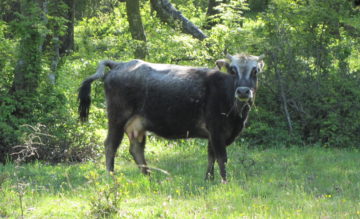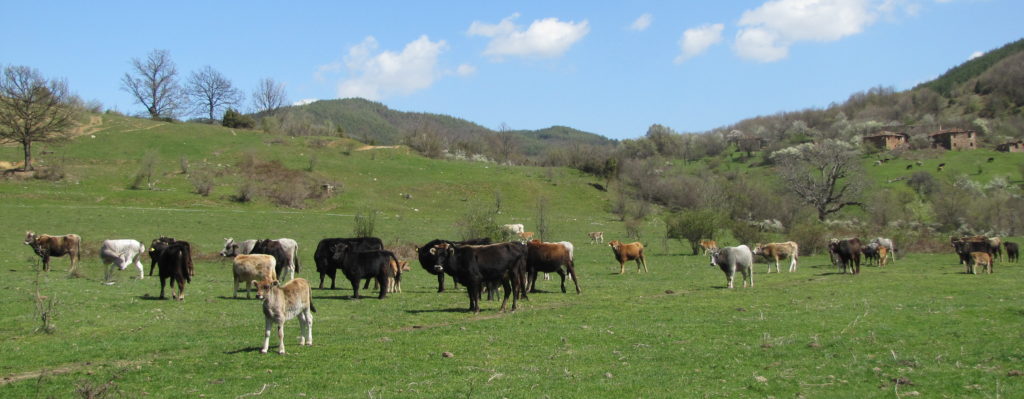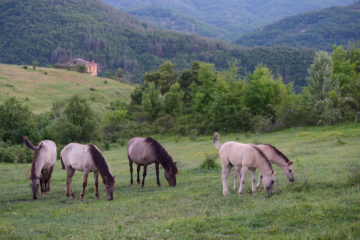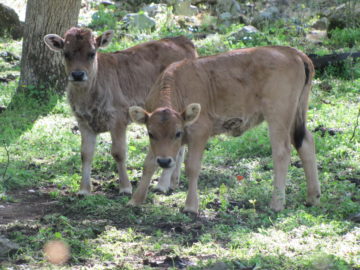Remarkable observations on reintroduced herbivores in the Rhodope Mountains give an insight into how different species make use of a shared defence strategy against predators. A promising indicator of their adaptive capacity to living in the wild and a prelude to the reintroduction of complex grazing systems in rural Europe.

This blog is a narration of personal observations. Although the observations described here are not (yet) recorded or otherwise confirmed, the story is exciting and the observations have potentially a big impact on our thinking about complex grazing systems, which makes it worth sharing. In combination with the proven effects of grazing systems on biodiversity and climate adaptation, these observations may outline the prelude to a new herbivore society in Europe.
Introducing Rhodope shorthorn cattle

Imagine the Rhodope Mountains around the year 2000. Increasingly, parts of the landscape are abandoned by traditional farmers and shepherds. Diverse landscape mosaics are getting overgrown with shrubs and trees, putting the incredible high biodiversity of half-open vegetations in this region at risk. A local team of conservationists decided to start the rewilding of a local primitive cattle breed; the Rhodopian Shorthorn.
From the last existing herds at farms, suitable individuals were gathered and brought together in social herds. Those herds could roam freely in the mountain areas, creating rich vegetation structures again. However, at the time there was still much uncertainty about how these herds would cope with predators. Would these free-ranging herbivores be able to cope with wolves?

Adaptation to the wild
The first results were not really encouraging. Many calves were predated in the first years of the project. But after the initial stage, the situation changed dramatically and less and less young animals became victims of wolf predation. What we had hoped for happened: the Rhodope Shorthorn cattle – used to their safe conditions at farms – had adapted to their new life in the wild.
As a defence strategy, cows and bulls were forming a safe circle at night, with their horns on the outside to keep wolves at bay, creating a safe inner circle for their calves. The strong social groups of cattle and their herd instinct made the animals more resilient to attacks from predators.
Another keystone species

As a next step in the reintroduction of complex grazing systems, a group of 12 Konik horses (or Tarpans as they are called in Bulgaria) was brought to the same area. We already knew from experiences in Latvia that these herds could pretty well defend themselves against wolves. Nevertheless, with the presence of larger wolf packs in Bulgaria, the animals might had to adapt.
Similar to the reintroduction of the shorthorn cattle, a lot of foals were predated in the first years and in these early years, the herds hardly grew. Until the moment that, again, predation decreased significantly and more and more foals survived. The question remained, however, how the animals managed to adapt. Unlike the cattle, the horses couldn’t use horns to defend themselves, could they?
Unprecedented observations
A local herdsman is looking at the free-roaming animals from time to time, and a few years ago he witnessed how the herds gathered and grouped at twilight. To his astonishment, the cattle did indeed circle their calves, but in the middle of that circle were not only the calves.

The Konik horses had also found a safe haven there. But there was more. Among the animals, within the safe circle, he also discovered a few roe deer! Wild animals, protected by former livestock that had learned to protect itself against large predators.
This type of defence strategy – forming a circle around the young – by a herd of the same species is known from other large herbivores, like musk ox. And some might add that cooperation against predators among species is even a well-known principle among wild herbivores on the African savannahs. However, here in Europe, such observations are unprecedented.
So far, we haven’t managed to take a photo of this phenomenon occurring among the large herbivores in the Rhodope mountains. An (anonymous) sponsor already offered 5,000 euro for a picture that proves this observation (contact us if you think you make a chance).
Grazing with a mix of large herbivores
The combination of these observations with the proven fact that less and less cattle and horses are predated in our rewilding area, makes us believe that with a mix of large herbivores we can create grazing systems in rural Europe that deliver results on biodiversity and climate adaptation – as other extensive grazing systems do – but at the same time are less vulnerable for predators. Not only does this underline the adaptive capacity of species to new circumstances, but it may also prove helpful in saving compensation costs and making human-wildlife coexistence much easier.
Hristo Hristov, Rewilding officer at Rewilding Rhodopes